Turnover Trends 2024: What Recruiters Need to Know
The unexpected economic tides of the last five years are still leveling out, and many recruiters are reeling over the ups and downs they’ve ridden since 2019.
Veering from panicked layoffs to frantic hiring in 2020, then the Great Resignation in 2021, another layoff trend in 2022 as the pandemic waned, and some floundering in both directions in 2023—where are we now?
Overall, recruiters should know that turnover has trended down so far in 2024 for many industries. This is a good thing for companies hoping to retain talent and keep their teams running smoothly—but it poses some challenges for those trying to fill new roles.
Employee Turnover Statistics by Industry
Although volatility has been pretty universal when it comes to turnover trends over the last several years, some industries have seen more chaos than others.
Let’s take a look at trends in data from the US Bureau of Labor Statistics, focusing on month-to-month (not seasonally adjusted) data from 2023-2024, and annualized data from 2019-2023. These statistics include all turnovers—voluntary and involuntary, total separations are measured in thousands.
Turnover in Manufacturing

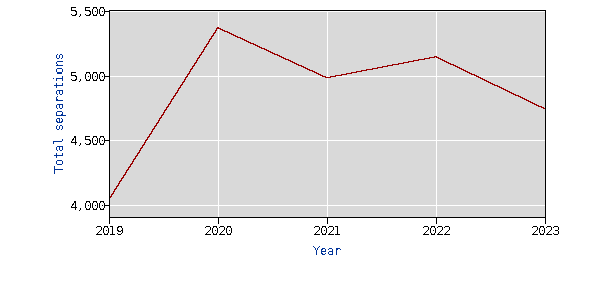
In the manufacturing space, turnover has slowed compared to the spike seen in 2020 but has increased so far this year. This is good news for retention, but for companies looking to fill open roles, it can be tough to attract new employees who are hesitant to change companies in a dicey economic environment.
Turnover in Retail


Retail businesses have finally reached turnover rates at or below pre-pandemic levels, which may help improve the operating challenges they’ve faced since 2020.
Turnover in Finance & Insurance

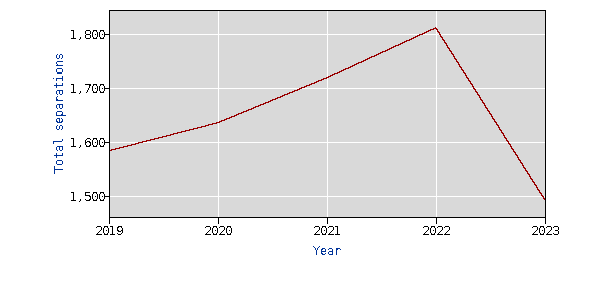
After a damaging round of layoffs in 2022, turnover in the financial and insurance industries was quite low by the end of last year—and it remained fairly low this spring.
Turnover in Professional & Business Services


Similar to the financial space, this broad category of professional services is seeing a lot of talent holding onto their current roles in the first half of 2024.
Turnover in the Information Industry


Employers in the information industry have had a steadier few years than most, but turnover trends are way down in early 2024.
Turnover in Public Education


Turnover in public K-12 education has seen a somewhat steady decline since its peak in 2020. The metric has been on a positive downward trend since 2022, and has stayed consistent with 2023 with the expected turnover bump in the summer months.
Turnover in Private Education


Private education turnover has largely mirrored public education, only on a smaller scale. Turnover peaked in 2020 and has seen a positive downward trend since 2022, and has also stayed mostly consistent with 2023 with expected turnover in the summer months.
Turnover in Healthcare & Social Assistance
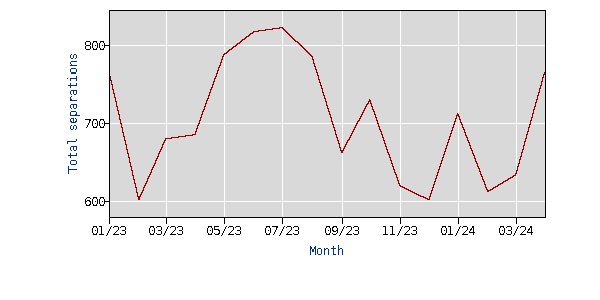
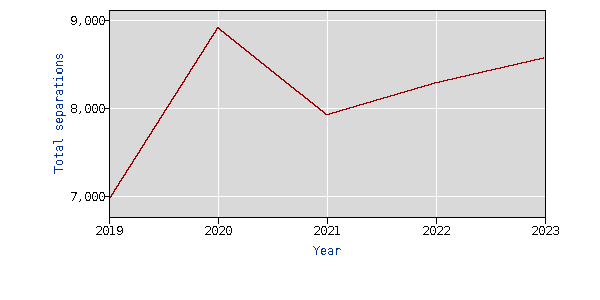
Although healthcare turnover remained stuck at a stubborn rate over the last few years, a dip in the data from January 2024 may suggest more stability this year.
Turnover in Government (Federal, State, & Local)
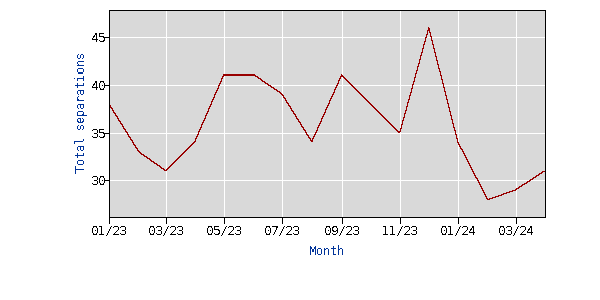

Total turnover rates remain low in the government sector and haven’t varied too much in recent years. However, it’s hard to say what this election year has in store for these trends come fall.
Turnover Trends and Predictions in 2024
According to a February poll, a third of hiring managers anticipate increased turnover in 2024. The earliest data from the year doesn’t quite show that trend, but as layoffs taper and redistribution solidifies in some industries, it’s certainly possible that some talent will explore new opportunities after hunkering down through an uncertain job market.
If lower turnover trends continue, it’s great news for employers who simply want to hold onto the talent they have and keep their teams operating without interruption. But for those with new or open roles to fill, it can be extra challenging to attract new candidates in a job market where people prefer to stay put.
Overall, with the economy still feeling unsteady for most consumers (who are also most employees), HR teams will be well-served by focusing on building and rewarding healthy, welcoming company cultures in 2024. That strategy, coupled with investing in an employee referral program, can aid in both talent retention and talent attraction.
Reasons Behind Turnover and Retention Rates
Perhaps unsurprising, in this context, is a survey that showed 51% of people who plan to look for a new job in 2024 cite higher salaries as their top reason for searching beyond their current employer.
Interestingly, 50% of people surveyed said they’d look for a new job if they don’t receive an expected promotion this year.
People leaders in all industries should take these insights to heart. Many employees would be happy to stay with their current companies—but economic pressures, as well as the desire for professional growth after an unpredictable few years, will force many to look for new opportunities in 2024 if their current employers can’t meet those needs.
Effects of Employee Turnover
As any seasoned HR professional knows, turnover can directly harm your business and have a ripple effect across your team—and your organization’s bottom line. For example:
- Turnover is expensive. The cost of replacing an employee can add up to 150% of that employee’s salary—even higher for higher-level positions in your organization.
- Turnover reduces productivity. Losing a team member causes work stoppage and knowledge loss that can have long-term effects on that team’s productivity and effectiveness.
- Turnover hurts team morale. Losing a colleague can feel a lot like losing a friend—and having to cover additional work because of a vacancy on one’s team can increase the risk of burnout and a sense of unappreciation.
Startlingly, more than 40% of turnover happens within the first month of a new hire—and at least another 10% quit within their first year. So while strong retention programs can help established employees feel empowered and appreciated, an intentional, engaging onboarding program is also essential to minimizing turnover.
Low turnover is a good thing for avoiding the above risks (and many more reasons)—but low turnover as an industry-wide trend doesn’t make recruiting easy when new or vacant roles need to be filled.
A survey from Morgan McKinley found that a lack of skilled candidates is the top challenge employers looking for new talent expect to face in 2024. It’s a valid concern; less mobility for employees means fewer qualified applicants.
Keep Turnover Trends Healthy and Teams Happy
It is possible to strike a balance and make positive waves for your organization in a tough talent market.
First, when it comes to holding onto the talent you already have on your team, it’s essential to build and socialize professional development paths for your employees. Make sure they know you’re ready to invest in their learning, growth, and advancement, and they’ll be more likely to stay and make a long-term career in your organization.
Second, make sure you really double down on a positive, efficient, and insightful recruiting process. When you do need to make a new hire, you want to find top talent, move them through your screening and interview pipeline quickly, and bring them on board smoothly to attract the increasingly rare candidates you’ll need to bring your next big goal across the finish line.
Leveraging exceptional, flexible recruiting software can help you avoid some of these common pitfalls, especially slow hiring processes and screening difficulties. You can even get more out of those tech investments by using them to up-level the onboarding experiences that will make new hires feel excited to stay a while.
Reach out to our team today to talk to one of our experts about how interviewstream’s video interviewing software, interview scheduling tools, and AI Recruiting Assistant can help you stay ahead of turnover trends in 2024 and beyond.
About The Author
Monique Mahler is the CEO of interviewstream. She is an avid researcher of facts, a self proclaimed marketing geek, and an equestrian in her spare time.
